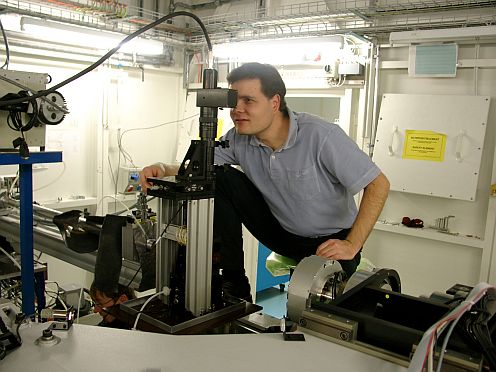|
"My goal is to build on the department's outstanding performance
and stimulate ideas for new applications in the field of fibres,"
said incoming department head Manfred Heuberger. "Empa already has
excellent contacts with the textile industry, but this country
needs new fibres. To continue to develop competitive products,
traditional capabilities must be supplemented by interdisciplinary
knowledge from the fields of chemistry, physics and biology. It
will also be important to demonstrate the potential of fibres in
entirely new domains such as electronics, nanostructures and
photovoltaics."
Manfred Heuberger was first attracted to physics by a
fascination with the stars. At university his interest shifted
"from the very large to the very small": physical processes on the
molecular and atomic level. In his doctoral dissertation "On Local
Properties and Adhesion of Metal Polymer Systems" under Professor
Schlapbach at the University of Fribourg, he addressed surface
physics on the nanometre scale (1991 to 1994). Applying the
then-new combination of atomic force microscope and scanning
tunnelling microscope, he demonstrated, among other things, how the
surface conductivity of conducting polymers depends on local
pressure. For this work he received the Swiss Association for
Microtechnics (SGMT) OMEGA Prize in 1995.
From thin lubricant films to joint fluids
In his first postdoctoral residence in Fribourg from 1994 to
1995, Dr Heuberger studied electrical microcontacts in
collaboration with ABB. Next he received two grants from the Swiss
National Science Foundation for postdoctoral work at the University
of California, Santa Barbara (1995 to 1997). There he studied
surface forces in organic films, demonstrating for the first time
that sub-nanometre oscillations reduce friction in thin lubricant
films.
He continued to pursue the topic on Professor Nicholas Spencer's
Surface Science and Technology team at the Swiss Federal Institute
of Technology (ETH) Zurich, which he joined in 1997. As Senior
Scientist, he studied the lubricating fluids that ensure smooth
movement in both natural and artificial joints. Together with the
ETH research team, Dr Heuberger showed how protein folding in
joint fluids affects surface adsorption capacity and thence
friction. The work led to new approaches to lubrication in
artificial hip joints. Dr Heuberger also examined friction
reduction through nanopatterning, the creation of nanometre-scale
patterns and structures on polymer surfaces such as hip
implants.
In addition to his research, Dr Heuberger was also an
active teacher. He supervised several thesis and doctoral
candidates and lectured on "Surfaces and Interfaces" and "Surfaces
of Biomaterials: Properties and Characteristics".
The unbroken thread in Dr Heuberger's career:
surface physics
Upon reading the recruitment notice for the new head of the
Functional Fibres and Textiles department, Manfred Heuberger was
immediately intrigued by the topic of fibres and surfaces. Surface
science had been the unbroken thread throughout his research
career. He assumed the post on 1 July 2005. His initial misgivings
about assuming management of an existing department soon
dissipated. "Today I am convinced that there is enormous potential
for innovation in fibres and I know that I have found the best
people to meet this challenge."
Author Dr Bärbel Zierl, Communication and
Marketing department, tel. (+41) (0)44 823 49 09,
Contact Dr Manfred Heuberger, Functional Fibres
and Textiles department, tel. (+41) (0)71 274 7878,
|

